
“Ben works year-round coppicing, wood-thinning and hedge-laying. He burns charcoal from spring to autumn, packages it and sells it for £6 a bag as barbecue fuel at Bridport market. Before all this, he was the creative director of a big London ad-agency.” – Ali Wood, Countryfile Magazine
What is charcoal making?
Charcoal making involves burning wood whilst controlling the amount of oxygen present. Very little oxygen is allowed in, and the slow burn results in a product (charcoal) that burns at very high temperatures, but produces very little (if any) smoke. Charcoal is one of the oldest commodities in the world. It provided the heat to smelt metals like iron and copper – so without it, the bronze age, iron age and industrial revolution wouldn’t have been possible. Nowadays, charcoal is produced in metal kilns, but originally it was made in earth clamps by piling up wood, covering it with turf to control the ingress of oxygen, and burning it slowly.

Coppicing was the usual way to provide wood for producing charcoal in a perpetually recurring cycle – but alas, as with most resources, it was over-exploited and resulted in massive deforestation in Europe and North America.
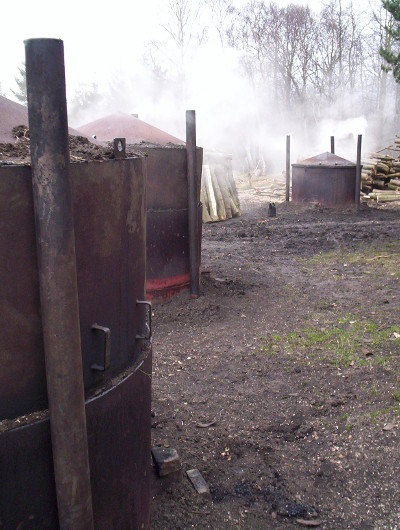
Charcoal has traditionally been used for blacksmiths’ forges; for drawing; as an ingredient in gunpowder; as a soil additive; for filtration; and for cooking. Nowadays most charcoal is used for barbecues. Charcoal briquettes are made by compressing charcoal made from sawdust etc, along with dust and a binder; lump charcoal is just the raw product from burning hardwoods.
What are the benefits of charcoal making?
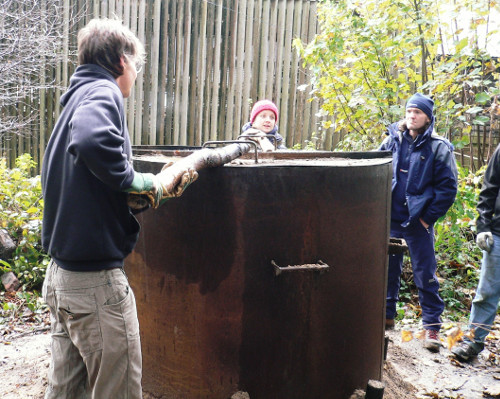
- Provides a market for poor-quality wood, although there’s much more of a market now for firewood, due to the recent increase in the use of wood stoves
- Buying locally-produced charcoal reduces the transport involved with imported charcoal, provides local employment and supports the local economy
- Helps manage woodlands; woods need to be thinned to produce a wide range of products, including timber, firewood and charcoal
- Locally-produced charcoal is a renewable, sustainable resource because the carbon released on burning is balanced by the carbon taken up by growing trees, and so cooking over charcoal saves on non-renewable fossil fuels
Great video showing the charcoal-making process by our friends Pete & Anna at the Bulworthy Project.
What can I do?
Getting started
You can make charcoal for your own use, and there is a small but growing number of people doing it commercially. It would be difficult to make a living from charcoal burning alone, but it could work as one element of a woodland business such as tree surgery, hedgelaying, forestry contracting, timber products, courses, firewood etc. The biggest market is for barbecue charcoal (and there are a few specialist suppliers of artists’ charcoal).

More and more people are buying small woodlands, or you could negotiate the use of someone else’s wood. Ask the Forestry Commission, the Woodland Trust, agents for large estates, or people you know with woodland. You may be able to produce charcoal there for free. If you don’t ask, you don’t get. However, the firewood market has taken off recently, so there is more demand for poor-quality hardwoods – the same raw material as for charcoal burning. So you may have to pay for the wood, even if you can put your kiln on the land for free. You could pay a forestry contractor to deliver timber to your kiln. Arborists working on street or garden trees often have a lot of cut crown wood from the tops of trees that they may have to pay to get rid of (local authorities sometimes charge £15-20 per load of waste wood, and convert it into woodchip and compost). They may be happy to deliver it to you for free.
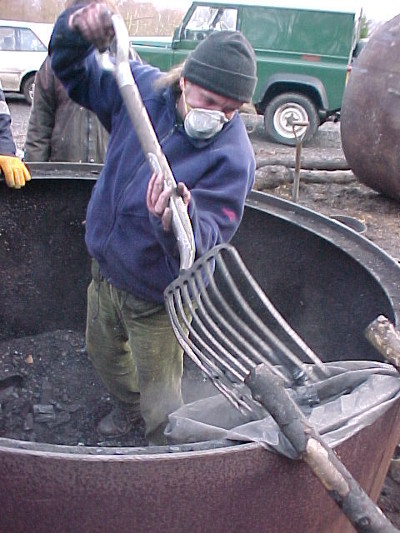
Start by attending a course to see how it’s done and to have a go. Here’s more detailed information about the burn itself.
Then buy a kiln, or if you only want a small one, you could convert a 45-gallon oil drum. There’s an explanation of how to do this in Coppicing and Coppice Crafts by Rebecca Oaks and Edward Mills. But you have to learn the art of charcoal making by actually doing it. Charcoal burning a scientific process, but there are so many variables, that it really does become an imprecise art.
The art of making woodland charcoal.
Variables include:
- species of wood used;
- moisture content of the wood;
- how wet the ground is and whether it’s free-draining or not (clay soils can be problematic, as a huge amount of water is driven off during the burn, and it has to go somewhere);
- the wind can inject unwanted oxygen; you can put hurdles around the kiln, although this is more of a problem on open land than in enclosed woodland;
- the time of year;
- how much oxygen you let into the burn;
- the skills of the charcoal burner.
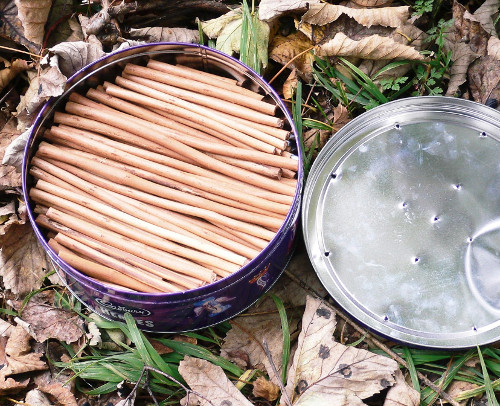
Regulations & other people
Talk to the planning department of your local authority first. You don’t need formal planning permission to site your kiln, as it will be temporary, but the local authority won’t like it if local residents complain about smoke in their house or garden. The planners probably won’t know much about charcoal burning, so you might like to invite them and show them a burn. It pays not to get in their bad books.
When you start a burn, before it gets up to operating temperature, there are usually huge clouds of smoke, and someone might call the fire brigade. You must tell the local fire brigade HQ that you are intending to start a controlled burn. Tell them when you’ve closed it down too. Plus it’s polite to tell any neighbours who might be affected by the smoke.
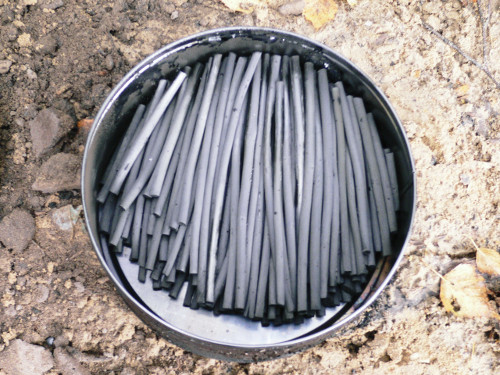
You need to get insurance before starting charcoal making. If you already have insurance for your business or for your woodland, then you can add charcoal burning to it.
Managing the burn
There are usually 4 inlet ports and 4 outlet pipes on a kiln. Typically, pipes (or chimneys) are 5″ (13cm) diameter. The inlets are at ground level. These are to control the oxygen input, by covering or partially covering the end of the inlet with a house brick or soil. A burn with a 6ft (2m) diameter ring kiln, approx. 1m high could take around 10 hours, depending on the variables above. Ideally, wood should be up to 4-5″ (10-13cm) diameter, or up to 3″ (8cm) for a small kiln / oil drum.
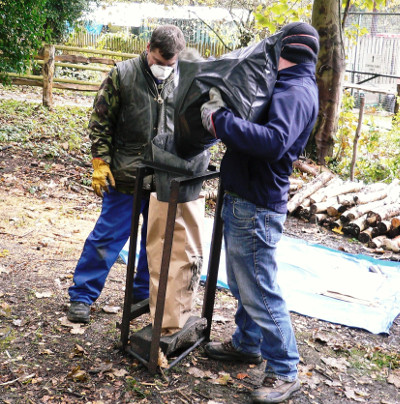
The burn should be managed – you should never leave a lit kiln, and you should stay with it for at least an hour after the burn has finished as well. The whole process from start to finish can take 3-4 days. On day one, get the kiln filled and ready to light. Start day two as early as you can – light the kiln around 5-6am, and be prepared to come home around 12 hours later. It’s best to leave the kiln for 24 hours to cool, so perhaps on day 4, lift the lid and carefully extract the charcoal. Most people use an asphalt / tarmac fork, or a potato fork – one with a good curve and lots of prongs. The charcoal needs to be graded and bagged. Grading can be done on a sloping chute of 17mm mesh (used for rabbit pens, and sold in rolls from pet supply shops). Grading allows small pieces and dust to fall through the holes – dust in the charcoal prevents it from burning well. It can then be tipped into sacks that can be carried easily, for use or for sale.

Kilns can be taken away, or left in the woods. The pipes can be taken home, or if it’s a mini-kiln, everything can be taken away in the back of an estate car. You can get the next load of wood delivered to your kiln, or you can roll the kiln to where the wood is stacked.
Here’s some more detailed information on the burn.
Buying charcoal
If you want a more sustainable product, look for lump charcoal, which is made from wood only. Briquettes can contain anything from limestone and borax to sodium nitrate and lighter fluid.
Thanks to Maurice Pyle of Woodsmith Experience for information, and Maurice Pyle, Ecclesall Woods Crafts & the Bulworthy Project for images.
Whilst you’re here, why not take a look at the other 20+ land related topics available? And don’t forget to visit our main topics page to explore over 200 aspects of low-impact living and our homepage to learn more about why we do what we do.
The specialist(s) below will respond to queries on this topic. Please comment in the box at the bottom of the page.

Anna and Pete Grugeon are partners in Bulworthy Project, the main income of which is from charcoal production. They have been teaching charcoal making since 2010 and have acted as consultants on sustainable charcoal production projects in the UK, Costa Rica and Nigeria. They’re passionate about the role charcoal production can play in sustainable land management.
The views expressed here are those of the author and not necessarily lowimpact.org's
26 Comments
-
1Cheryl Hill May 4th, 2017
Good info, good ideas re sourcing wood to make charcoal from. No mention of use for charcoal in agriculture which will be a very important means for large scale sequestering of carbon. Also no mention of what you do with the charcoal dust, which would be perfect for this purpose. Look up Terra Pretta. I am wanting to set up Biochar production for agricultural purposes, and will be experimenting with alternative supplies to wood, certainly, I don’t think I will be rejecting any waste hedge trimmings or such like, so I am planning to approach tree surgeons, and follow up on your other suggestions. I understood that the gasses given off include methane, which is a worse greenhouse gas than carbon dioxide, there should be potential to capture and harness waste gasses for use – so if it is at all possible we should be thinking about this. I am waiting for someone to manufacture a domestic heating system that produces Biochar instead of releasing carbon into the atmosphere… I would be very willing to test pilot any ideas and collaborate.
-
2Dave Darby May 5th, 2017
Hi Cheryl. We’re going to be adding biochar as a new topic at some point. We’ll be interviewing specialists – but it’s quite controversial, isn’t it?
-
3Anne Troop October 28th, 2017
Please can you advise. Are there any regulations regarding how close to a domestic dwelling a charcoal burner can be placed? We live on the edge of a wood with continuity of trees from the wood to our garden and close to the house. A charcoal burner has been set up in a small clearing about 100metres from our house? Is there any danger of setting fire to the trees and our house ? Thank you. Anne
-
4Pete Grugeon October 28th, 2017
Hi Anne. There’s really no need to worry. Our kiln is only 20m or so from our house, just the other side of our woodshed. When the kiln is lit the fire is contained inside. You have more to worry about with a campfire. I hope that this puts your mind at ease.
-
5Anne troop October 28th, 2017
It does. Thank you very much. Anne.
-
6Mia June 10th, 2019
Hi I am starting charcoal burning on my woodland that I own
Am I allowed to build a dwelling and if so what is the square footage
And is it considered a permitted dwelling
-
7Pete Grugeon June 19th, 2019
Potentially yes, you can live there, but it’s not straightforward.
If you’re serious about this, buy this handbook: http://tlio.org.uk/rural-planning-handbook/
-
8Ed July 10th, 2019
A problem I’ve found when charcoal burning is for the kiln to lose temperature mid way through burn. I use traditional ring kiln with dried hard wood. Have reignited kiln by opening all vents and sometimes lid slightly, then closing up, once water applies to outside sizzles. But always worries that the burn will just end up with brown ends. Any advice on best method if kiln does cool Part way through burn would be great!
-
9Pete Grugeon July 10th, 2019
I would work out why the kiln is losing heat. If the setup is correct, there’s no reason for it to do that. The temperature should continually rise until you close the kiln down at the end of the burn.
Are you leaving the wood in long lengths so that it doesn’t collapse properly as the middle burns out?
Are your vents/chimneys too narrow or clogged up?
Is the wood seasoned for at least 6 months?
Are you following the method used in http://www.devoncharcoal.uk/howto ? If not, what method are you using?
-
10Kate October 7th, 2019
Hi, I am exploring charcoal production on a small scale. What are the regulations do I need a waste processing licence or similar from a government body if so which one? Thank you Kate
-
11Pete Grugeon October 8th, 2019
Hi Kate, no license is required. The only issue is if you cause a nuisance to your neighbours.
-
12jane clement April 20th, 2020
Hello, i have woodland and would like to make charcoal either on my own or inpartnership. I have no experience and wonder if you could advise where/how to start.
-
13Dave Darby April 20th, 2020
Hi Jane – the introduction above is about how to get started, plus this article might be useful – https://www.lowimpact.org/career-change-not-enough-charcoal-makers-satisfy-demand-home-produced-charcoal/. Is there anything specific you’d like to know that’s not in either of those?
-
14Jane April 20th, 2020
Thanks for that Dave I’ll have to go on a course when we’re back to normal. Do you know anyone in staffs or derbys looking to expand which might be I interested in a partnership?
-
15Carlos May 14th, 2020
Hello, thank you for all the information, I am in Spain and I would like to start small charcoal production. I would like to know if you have any technical specifications about how to built the metallic ring kiln. Thank you in adcance.
-
16Dave Darby June 2nd, 2020
Carlos – this is more a metal fabrication question, rather than charcoal-making. I’ll see if we can find a fabricator to answer it for you.
-
17David steele July 21st, 2023
Low impact?! Not if you’re unfortunate enough to live downwind !! Should have been banned at the same time as stubble burning. Polluting & no place in the 21st century
-
18Cheryl Hillier July 24th, 2023
I am now proud to be cooking and heating my home and hot water in a carbon negative process while making Biochar for use as a soil improver on the land to improve moisture retention, soil biology and sequester carbon permanently.
I took the grate out of the firebox of my stove, used an iron rod to balance logs across, made a hopper to fit in the ash drawer area, and cut a one inch slot for the char (The wood loses it's integrity as it turns to char) to fall through into a stainless steel quench pot in the warming drawer beneath.
We should not be chopping down trees to make charcoal outdoors for use on BBQs. Certainly not importing it from Africa causing deforestation to cook sausages.
-
19Pete Grugeon July 24th, 2023
Cheryl Hillier
I'm intrigued by how you heat your house in a carbon neutral way. Do you mean that it's carbon neutral because the carbon in the wood is part of a carbon cycle and is returned when the trees regrow? If so, you surely accept that charcoal is carbon neutral for the same reason.
-
20Cheryl Hillier July 28th, 2023
Pete Grugeon
It's not a carbon neutral process, it is carbon negative because the char is returned to the ground where it is permanently sequestered as a soil improver. So I cook and heat my home and hot water on the stove using the heat from the syn gasses as they are burned, but retaining the char for sequestration.
Trees are part of a carbon cycle, but when you burn char, you are still adding carbon to the atmosphere, releasing all that carbon that the tree was storing.
Don't use char to cook sausages, use the heat from the charcoal process to cook your sausages, and then use the char to add water holding capacity to soils, improving the biology, and sequester it permanently.
-
21Pete Grugeon July 28th, 2023
Cheryl Hillier
How are you testing that no carbon is combusted, just the gas. I'm interested in the methodology.
Do you do all of your cooking on this? If not, what method do you use to cook on, which is more carbon efficient than charcoal from sustainable land management?
-
22Cheryl Hillier July 29th, 2023
OK so it's not an exact process, like the Amazonians making Terra Preta thousands of years ago, there is some ash, but so what?
The overall aim is to sequester most of that carbon, instead of burning it.
We light the fire morning and evening to make hot water if it is needed (It's kept in a thermal store) and will use this heat to cook on but if there is no need for hot water, or it's already too hot, we would not waste the heat from the wood just to cook on. We have an induction hob for cups of tea, ideally all electricity should be from renewables, we haven't got solar panels yet but we do pay for a green tariff.
Charcoal form sustainable land management is obviously 'better' than charcoal from unsustainable land management, but I can't see the ecological sense in not using the heat from the process used to make the product you use to cook on, when you could just use wood in the first place? It's a very wasteful process, and if you don't burn off the syn gasses, (Why not use these?) these are worse GHG's than the CO2.
Use charcoal to sequester carbon and repair soils, don't burn it, unless you need to eg for black smithing.
We need to sequester carbon at this stage because if we stopped burning carbon today, we are still heading for 2.5 degrees or more.
It's the end game.
Sequestering carbon is the only hope we have left.
Adding Biochar to soils not only sequesters carbon, it improves/restores the soils ability to sequester carbon too.
-
23Cheryl Hillier July 29th, 2023
There is also a good market for Biochar - need to inoculate it first though.
This would make a very sustainable income stream if you can figure out how to make it without wasting the energy or syn gasses produced.
Charcoal BBQ's are not sustainable.
You get much more heat from far less wood with rocket stoves, there are some designs for combining rocket stoves with Biochar kilns, the Hookway retort stole it's design from Ed Revill, look Ed up, he knows a thing or two about sustainability.
-
24Pete Grugeon July 29th, 2023
Cheryl Hillier charcoal barbecues are far better for the environment than your induction hob, which runs mainly on fossil fuels. The carbon cycle of sustainable forestry makes it carbon neutral and a fair amount of charcoal, which is too small for bbqs ends up as biochar or equivalent, which makes it carbon negative.
-
25Cheryl Hillier January 14th, 2024
Pete Grugeon,
How many people light their BBQ to make a cup of tea??
You could better argue that making cups of tea throughout the day is unsustainable, along with importing tea and coffee, and the forests cut down to grow these commodities.
Why settle for carbon neutral, when you can have carbon negative?
Use the heat energy from making the char to cook, and heat homes and water while sequestering ALL the carbon/char to repair the severely denatured soils, replacing the carbon stripped by intensive farming methods that are not resilient enough to provide food security owing to the weather extremes this carbon at loose in the atmosphere causes.
-
26Cheryl Hillier January 18th, 2024
Although woodland management can be sustainable, at the end of the day, burning charcoal just releases the carbon stored by trees into the atmosphere, and unless retorts are designed to manage/collect the syngas these green house gasses too are released into the atmosphere and are worse than CO2. Making charcoal is a great way of sequestering carbon, there are many uses for it, making lightweight concrete for instance, but the services it provides when you add it to soil greatly improve resilience to drought and flood and help restore the biology - it is relatively inert and will store that carbon indefinitely... unless you burn it.





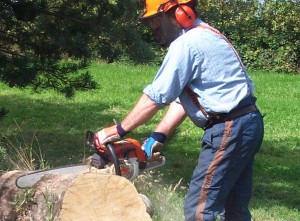 Chainsaws
Chainsaws
 Gasification
Gasification
 Tree / woodland management
Tree / woodland management


